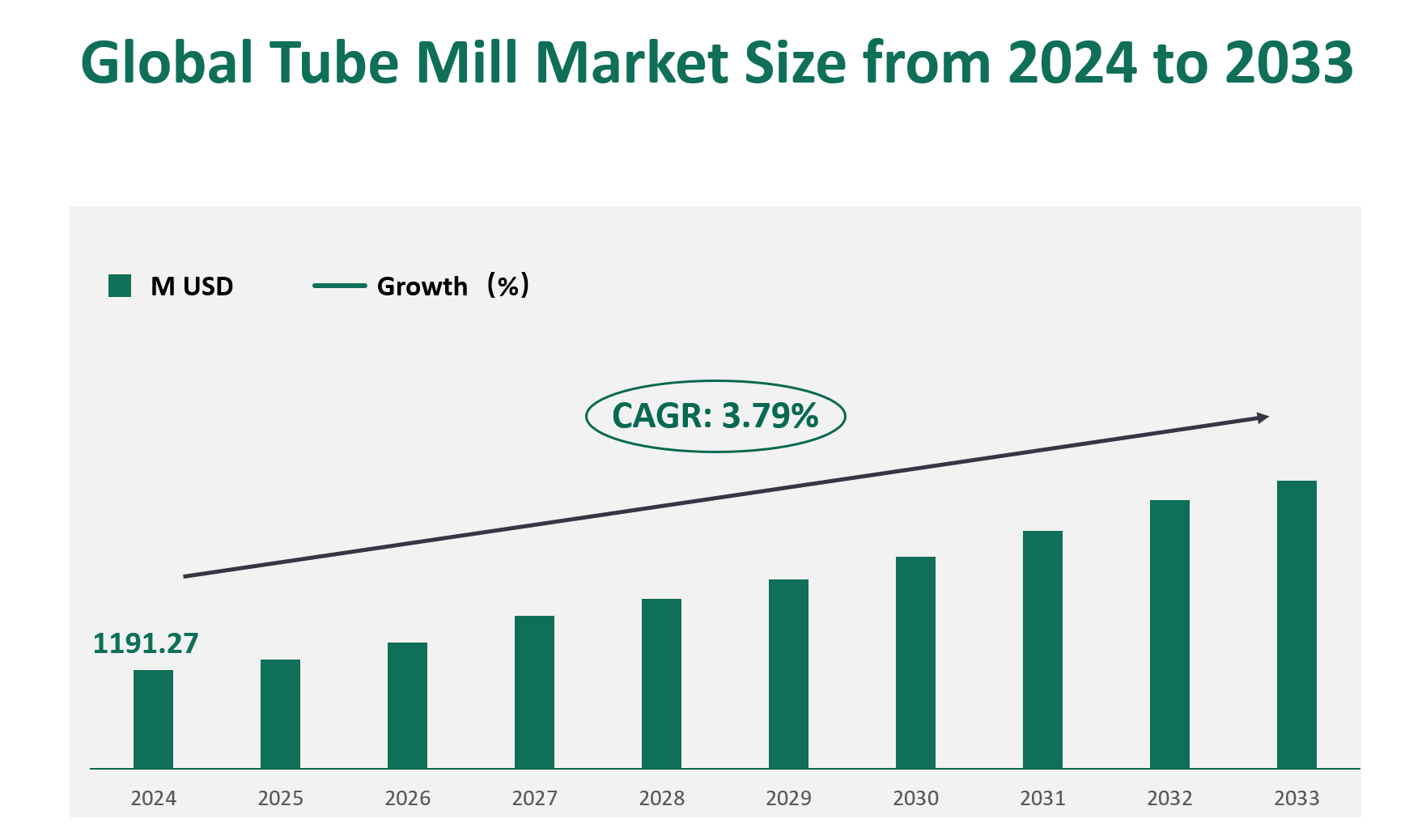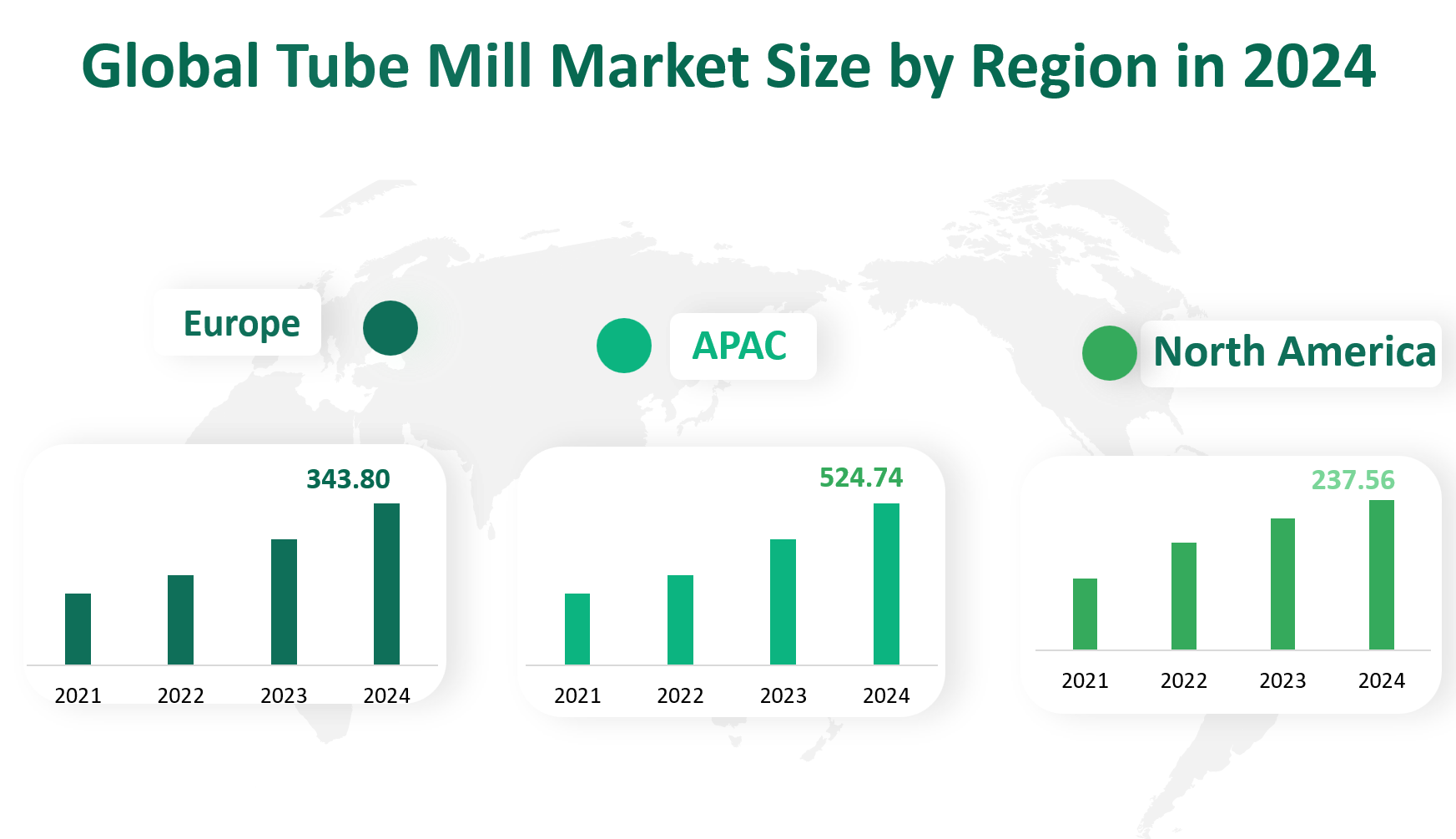1. Global Tube Mill Market Insight Analysis
The global Tube Mill market is projected to reach a value of $1191.27 million USD in 2024, with a Compound Annual Growth Rate (CAGR) of 3.79% from 2024 to 2033.
A tube mill is a specialized type of welded roll form system designed to produce tubes and pipes at high speeds and with high precision. These mills are fine-tuned to operate within specific diameter ranges, making them highly efficient for mass production of tubes used in various applications. The tube mill industry plays a crucial role in the global manufacturing sector, providing essential components for infrastructure, transportation, and industrial applications. The market’s growth is closely tied to the health of these downstream industries, which are increasingly seeking high-quality, cost-effective tube solutions.
Figure Global Tube Mill Market Size (M USD) and CAGR (2024-2033)

2. Driving and Limiting Factors of Tube Mill Market Growth
The increasing demand for customized mass production is a significant driver of the Tube Mill market. Modern industries, particularly automotive, construction, and oil and gas, require high-quality, precision-engineered tubes to meet their specific operational needs. Tube mills offer the flexibility to produce tubes in various sizes, materials, and configurations, making them ideal for these sectors. This demand for customization is further fueled by the growing trend of Industry 4.0, which emphasizes automation, robotics, and advanced manufacturing technologies to enhance productivity and efficiency.
Technological advancements have also played a crucial role in driving the Tube Mill market. Innovations in high-frequency welding, laser cutting, and digitalization have significantly improved the precision, speed, and efficiency of tube production. These technologies not only reduce production costs but also enhance product quality, making tube mills more attractive to manufacturers. The integration of the Internet of Things (IoT) and automation has further streamlined production processes, enabling real-time monitoring and predictive maintenance, thereby reducing downtime and improving operational efficiency.
The expansion of industrial activities in emerging economies, particularly in the Asia-Pacific and South America regions, is another key driver. Rapid urbanization and infrastructure development in these regions have increased the demand for tubes and pipes in construction and industrial applications. Governments in these regions are also implementing policies to promote the growth of the manufacturing sector, providing a favorable environment for the tube mill industry.
The shortage of skilled labor is another critical constraint. Tube mills rely heavily on skilled technicians and operators to ensure optimal machine performance and product quality. The lack of trained personnel in some regions can hinder the industry’s ability to scale up operations and meet growing demand. This skills gap is further exacerbated by the rapid pace of technological change, which requires continuous training and upskilling of the workforce.
Fluctuating raw material prices also pose a significant challenge. The cost of steel and other metals can be highly volatile due to market conditions and geopolitical factors. These price fluctuations can impact the profitability of tube mill manufacturers and affect their ability to maintain competitive pricing. Additionally, the availability and quality of raw materials can vary, leading to supply chain disruptions.
Environmental regulations are another limiting factor. Governments are increasingly implementing stringent regulations to reduce carbon emissions and promote sustainable manufacturing practices. While these regulations are essential for environmental protection, they can impose additional costs and compliance requirements on tube mill manufacturers. These regulations may necessitate investments in advanced technologies and processes to meet environmental standards, adding to the operational burden.
3. Technology Innovation and Corporate Mergers and Acquisitions in Tube Mill Market
Technological advancements have been a cornerstone of the Tube Mill market’s growth. High-frequency welding technology, for instance, has revolutionized the production process by enabling faster and more precise welding, resulting in higher-quality tubes. This technology is particularly beneficial for producing tubes with thin walls and complex geometries, which are in high demand in industries such as automotive and aerospace.
Laser cutting and forming technologies have also made significant inroads in the tube mill industry. These technologies offer unparalleled precision and flexibility, allowing manufacturers to produce tubes with intricate designs and tight tolerances. The integration of automation and robotics has further enhanced production efficiency by reducing labor costs and improving product consistency. Automated systems can perform tasks such as material handling, welding, and quality control with high precision and reliability.
The adoption of digitalization and the Internet of Things (IoT) is transforming the tube mill industry. These technologies enable real-time monitoring of production processes, predictive maintenance, and data-driven decision-making. By leveraging IoT, manufacturers can optimize operational efficiency, reduce downtime, and improve overall productivity. Advanced analytics and machine learning algorithms can also be used to analyze production data, identify trends, and make informed decisions to enhance production processes.
Strategic alliances and partnerships are common in the Tube Mill market, as companies seek to leverage complementary strengths and expand their market reach. These collaborations enable companies to share resources, technology, and expertise, thereby enhancing their competitive position in the global market. For example, T&H Lemont’s recent shipment of a new stainless steel TIG tube mill to a Midwest medical and aerospace tubing company highlights the importance of strategic partnerships in meeting specific customer needs.
4. Global Tube Mill Market Size by Type
The tube mill market is primarily segmented into two major product types: High Frequency Weld Tube Mill and Stainless Steel Tube Mill.
Definition: High Frequency Weld Tube Mills are designed to produce a variety of iron pipes, water pipes, and other tubular products. These mills are known for their efficiency and ability to operate at high speeds, making them ideal for mass production. They utilize high-frequency welding technology, which ensures precision and durability in the final product. The market revenue for High Frequency Weld Tube Mills is projected to reach 414.92 million USD in 2024.
Definition: Stainless Steel Tube Mills are specialized in producing high-quality stainless steel pipes used in decorative applications, automotive exhaust systems, and heat exchangers. These mills are designed to handle stainless steel materials, ensuring that the final products are corrosion-resistant and suitable for high-performance applications. The market revenue for Stainless Steel Tube Mills is forecasted to be 776.36 million USD in 2024.
Table Global Tube Mill Market Size by Type in 2024
5. Global Tube Mill Market Size by Application
Seamless steel pipes are produced using tube mills equipped with multiple rollers and internal tools. These pipes are used in applications requiring high pressure and durability, such as oil and gas pipelines, boiler tubes, and mechanical components. The market value for seamless steel pipes is projected to be 218.31 million USD in 2024.
Ordinary pipes include a wide range of steel pipes used in construction, plumbing, and general industrial applications. These pipes are produced using various welding and forming techniques, depending on the specific requirements. The market value for ordinary pipes is forecasted to be 807.71 million USD in 2024.
Large pipes are produced using specialized tube mills capable of handling large-diameter materials. These pipes are used in applications such as large-scale construction projects, water supply systems, and industrial pipelines. The market value for large pipes is expected to reach 91.98 million USD in 2024.
Table Global Tube Mill Market Size by Application in 2024
Application | Market Size (M USD) 2024 |
Seamless Steel Pipe | 218.31 |
Ordinary Pipe | 807.71 |
Large Pipes | 91.98 |
Other | 73.27 |
6. Global Tube Mill Market by Top Regions
North America: The North American market is expected to be valued at $237.56 million USD in 2024. This region has historically been a strong market for tube mills, driven by robust industrial activities in the United States, Canada, and Mexico.
Europe: Europe is anticipated to have a market value of $343.80 million USD in 2024. The region benefits from a well-established industrial base, particularly in Germany, the UK, France, Italy, and Spain.
Asia-Pacific: The Asia-Pacific region is projected to be the largest market by revenue, with a value of $524.74 million USD in 2024. This region’s growth is fueled by rapid industrialization, urbanization, and infrastructure development, particularly in China, Japan, South Korea, India, and Southeast Asia.
South America: South America is expected to have a market value of $49.19 million USD in 2024. While smaller in comparison to other regions, it is experiencing steady growth driven by countries such as Brazil, Argentina, and Colombia.
Middle East and Africa: The Middle East and Africa region is projected to be valued at $35.99 million USD in 2024. This region’s market value is influenced by oil and gas activities, particularly in Saudi Arabia, UAE, Egypt, and South Africa.
Figure Global Tube Mill Market Size by Region in 2024

7. Global Tube Mill Market Analysis by Major Players
7.1 SMS Meer:
Company Introduction and Business Overview: SMS Meer is a leading provider of tube and pipe production solutions, with over 130 years of experience. Established in 1885, the company offers a comprehensive range of products and services, including ERW welded tube plants and seamless pipe making technologies. SMS Meer’s manufacturing bases are primarily located in Europe, Asia, and North America, with a global market distribution.
Products Offered: SMS Meer specializes in electric resistance welding (ERW) tube plants, which cover product diameters ranging from 10 mm to 710 mm with variable wall thicknesses. These plants are tailored to meet the specific requirements of various end-use industries, including automotive, oil and gas, and construction.
7.2 Fives OTO S.p.A.:
Company Introduction and Business Overview: Fives OTO S.p.A. is a renowned provider of mill equipment, with a history dating back to 1896. The company offers a wide range of products, including tube mill lines, straightening products, and other related equipment. Fives OTO S.p.A.’s manufacturing bases are primarily located in Europe, with a global market distribution.
Products Offered: Fives OTO S.p.A. specializes in ERW tube mills, which cater to carbon and stainless steel tube production with diameters ranging from 4 mm to 762 mm and wall thicknesses from 0.4 mm to 28 mm. The company’s tube mill lines feature advanced technologies for high productivity and reduced downtime.
7.3 Zhongtai Group:
Company Introduction and Business Overview: Zhongtai Group is a leading manufacturer of ERW pipe making machines, established in 2000. The company specializes in designing and manufacturing high-speed precision pipe making machines, API pipe making machines, and other related equipment. Zhongtai Group’s manufacturing bases are primarily located in Asia, with a strong market presence in the region.
Products Offered: Zhongtai Group offers a variety of tube mill products, including ERW20 and ERW89 pipe mills. These mills are designed to produce welded pipes with specific diameters and wall thicknesses, catering to the needs of various industries.

